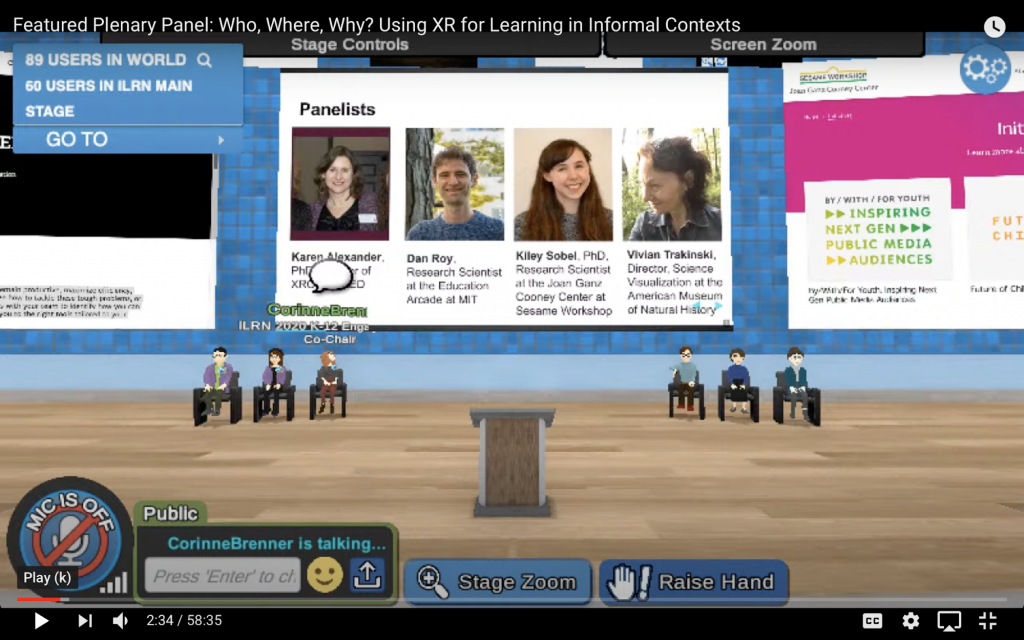Corinne Brenner, a researcher and learning scientist at Killer Snails, a development studio that produces science games, moderated a panel at iLRN 2020 about the use of XR for learning in informal environments on June 25, 2020. Corinne shares highlights from the panel, which took place in a virtual environment, with us here.
The Immersive Learning Research Network (iLRN) was uniquely equipped to rethink the plans for its 6th annual conference in light of COVID-19. The organization’s members are at the forefront of innovating and sharing immersive experiences for education, so they were willing to explore new technologies and translate the planned events to be entirely online experiences.
In the featured plenary panel “Who, Where, Why? Using XR for Learning in Informal Contexts,” I moderated a discussion between four researchers and practitioners who use virtual, augmented, and mixed reality in a variety of informal learning contexts. A recording of the panel is available here. We (or rather, our customized avatars) were “onstage” speaking in front of a virtual audience from around the world, while our real-world selves were all at a safe physical distance. The audience was able to zoom in to the slide deck, and react and pose questions throughout the panel via a chat interface in VirBELA and YouTube comments. iLRN’s Discord channel also provided a way to continue conversation threads and connect with panelists and interested participants.

During the panel, we started by sharing the who, what, and why of each panelist’s work with XR: the populations they work with, examples of their XR projects and content domains, and why XR is the right tool for education in their informal setting.
Karen Alexander, the director of XRConnectED and co-president of the Pittsburgh Chapter of the VR/AR Association, facilitates community-based out-of-school programs in Pittsburgh, PA. Children, teens, and adults learn to use XR authoring tools and tell stories in new media, using interdisciplinary and collaborative skills. Karen shared how during a workshop at the Lighthouse Project, students learned that 17-year-old Antwon Rose had been shot in the back and killed while fleeing from the police. As a result, one of the groups made their 360 video on gun violence. A link to that video can be found here.
Dan Roy is a Research Scientist at the MIT Education Arcade. Dan leads game design for the Collaborative Learning Environments in VR project, and spoke about using the game Cellverse in a museum setting to test an exploration of cellular biology with diverse audiences, as well as the impact working on the project had on undergraduate students developing the project. This was often the first experience using VR for many people in the museum, so having staff nearby to help guide users’ experience with the hardware was key. By helping users become comfortable enough to explore the virtual environment, they could actually engage with the content to be learned. The team used this experience in their design of a non-player character and tutorial in the app.
Kiley Sobel spoke about her experience researching children and families’ use of XR with games like Incloodle and Pokémon Go, as well as her work as a Research Scientist at the Joan Ganz Cooney Center focusing on the responsible, inclusive, and equitable design of emerging technologies and new media for children. For children, social-emotional learning and skills like sharing are often learning goals in informal learning contexts. The concept of joint media engagement captures what happens when people learn together with media. In Kiley’s experience, XR games created opportunities to negotiate physical space, handle a shared device, and take on roles like using an iPad camera to take a picture of another user.
Vivian Trakinski works with XR in her role as the Director of Science Visualization at the American Museum of Natural History. The audience of visitors at the museum includes many different types of learners who have their own learning goals. Like Dan, Vivian described a VR installation that required docents to guide people to using VR head-mounted displays and controllers for the first time. Designing experiences for all ages, levels of background knowledge and English proficiency, and often very limited time is a challenge. XR experiences at the museum have been successful when they use the genuine artifacts of science and put them in an environment for deep exploration. In areas of study like climate change and biology, those artifacts may be large datasets, or digitized collections. This work will continue with a project exploring how immersive technology and data visualization can combine to give museum audiences more context for exhibited objects.
Audiences appreciated hearing about the variety of applied examples, but also had great questions for the panelists expand on. Karen, Vivian, and Kiley’s experiences with neurodiverse learners and XR ran the gamut from creating new projects in a Pittsburgh after-school program, designing an inclusive game for children with mixed abilities, and designing museum installations to be accessible to as wide an audience as possible.
A concern of audience members and panelists was how COVID-19 would change the way we interact with XR tools. Most panelists mentioned how the expensive hardware was a limiting factor in sharing their work or conducting research, and sanitizing devices or obtaining a 1:1 ratio of students to devices would be a challenge. COVID-19 represents challenges to the way makerspaces and museums have been functioning the last few years, but the panelists could also imagine ways to adapt. Vivian shared a project at AMNH bringing more of the collection into the digital world. The many millions of artifacts can never be shared with the same depth and care in the physical location of the museum, but the potential for XR tools to transcend physical boundaries opens up new opportunities.
One of the most interesting aspects of the conversation was how each panelist talked about how their design process accounted for challenges. In museums and out-of-school settings, their project was often the first time participants used XR interfaces. Planning for interruptions and limited time with the technology made the experiences mentioned more usable, enjoyable, and informative from a learning perspective.
Thanks again to the panelists and conference organizers for inspiring this conversation!
 Corinne Brenner is a researcher and learning scientist with Killer Snails, where she helps create and study games that inspire a love of science. She is also pursuing a PhD in Educational Communication and Technology at NYU. Corinne’s research interests include applying quantitative methods to understand human behavior, impact evaluation, and examining the affordances of immersive technology for education and entertainment. She received her BA in Psychology from Cornell University, and MSc in Social Psychology and Psychological Methods from the University of Amsterdam.
Corinne Brenner is a researcher and learning scientist with Killer Snails, where she helps create and study games that inspire a love of science. She is also pursuing a PhD in Educational Communication and Technology at NYU. Corinne’s research interests include applying quantitative methods to understand human behavior, impact evaluation, and examining the affordances of immersive technology for education and entertainment. She received her BA in Psychology from Cornell University, and MSc in Social Psychology and Psychological Methods from the University of Amsterdam.

